UAE Population Report 2021
The face of the UAE is changing. When comparing the 2021 UAE population statistics with the previous years, it is evident that the change is at its peak today. With more foreigners, the country is now ethnically more diverse than ever before.
There is no single reason why people keep flocking into the country. It could be the liberal tax policies of the government, the beaches or the ministry for happiness and well being.
Believe it or not, the latest stats say that even in the midst of Covid-19, there is a 0.05 million increase in population from last year’s figures. Let’s get down to the details.
When researching for this article, we came across many conflicting figures for the population of the UAE in 2021. We were looking at data from a host of different institutions, who had used their own systems and methodologies to arrive at their figures. In the end, we chose to go with the United Nations’ data as it would be more or less in line with the UAE government’s official data.
UAE Population 2021 (Top Picks)
- UAE Population in 2021 is 9.99 Million according to the data provided by the United Nations.
- The Population Density in the United Arab Emirates is 118 per square kilometer.
- The Total Expat Population of UAE in 2021 is 8.84 million.
- Dubai Population in 2021 is 3.43 Million according to official Dubai Government website.
We have listed out these different figures in the following table.
| Sources | Population | Year |
| United Nations | 9,991,000 (9.99) | 2021 |
| CountryMeters.info | 10,051,926 (10.05) | 2021 |
| Worldometers.info | 9,973,977 (9.97) | 2021 |
| Statista.com | 11.42 | 2021 |
| Worldpopulationreview.com | 9,959,169 (9.96) | 2021 |
| PopulationPiramid.net | 9,991,083 (9.99) | 2021 |
UAE Population Statistics by Year (Historical Population)
| Year | Population |
| 2021 | 9.99 Million |
| 2020 | 9.89 million |
| 2019 | 9.77 million |
| 2018 | 9.54 million |
| 2017 | 9.40 million |
| 2016 | 9.27 million |
| 2015 | 9.15 million |
| 2014 | 9.07 million |
| 2013 | 9.0 million |
| 2012 | 8.90 million |
| 2011 | 8.67 million |
| 2010 | 8.27 million |
UAE Population Report by Nationality in 2021
According to sources, the 2021 UAE population including expatsis 9.99 million. The total expat population in UAE has now come to 8.84 million, which constitutes approximately 89% of the population. Emiratis or the UAE nationals are only 11% or 1.15 million today.
| Nationality | Population |
| India | 2.75 million |
| Pakistan | 1.27 million |
| Bangladesh | 0.74 million |
| Philippines | 0.56 million |
| Iran | 0.48 million |
| Egypt | 0.42 million |
| Nepal | 0.32 million |
| Sri Lanka | 0.32 million |
| China | 0.21 million |
| All other countries | 1.79 million |
| Total Expat Population | 8.84 million |
While taking a closer look at the 2021 UAE population by nationality, there are people from more than 200 nationalities living and working in the country. Currently, the Indian population in UAE is the highest with 2.75 million, followed by Pakistanis with 1.27 million. The UAE has around 0.75 million Bangladeshi nationals, 0.56 million Filipinos, and 0.48 million Iranians. There are also people from Egypt (0.42 million), Nepal (0.32 million), Sri Lanka ( 0.32 million), China (0.21 million) and the rest of the world (1.79million).
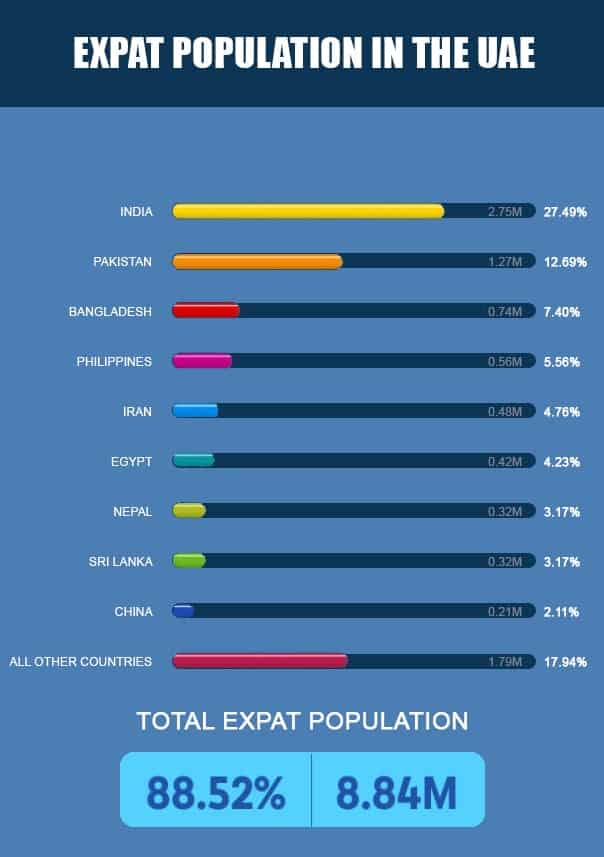
Demographics of UAE in 2021
Considering the demographics of the UAE population, the nationals make up a mere 11%, while expatriates 89%. The current net migration rate is 1.93 per 1000 population. The population is heavily concentrated in the northeast region of the country, where the three largest Emirates – Abu Dhabi, Dubai, and Sharjah – are located. The area alone is home to 75% of the population.
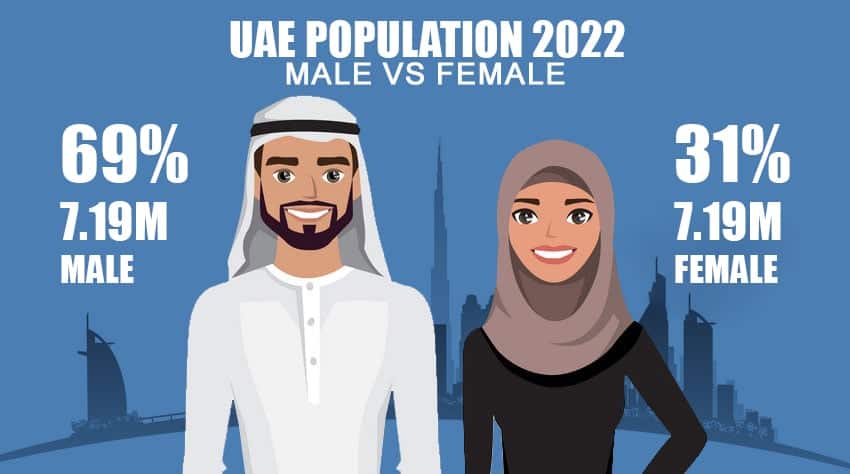
With 69% males and 31% females, the UAE has not yet achieved gender parity. This is visible across all age groups. With more expatriates, the majority of the UAE population (66.35%) falls into the 25-54 age bracket.
According to recent statistics, the birth rate of the UAE is 10.110 births per 1000 people, and the death rate is approximately 2 deaths/1,000 population. The total fertility rate (TFR) in the country is registered at 1.73 live births per woman. The infant mortality rate is 5.3 deaths/1,000 live births while the average life expectancy is 79 years.
UAE Population Report by Age
| Age Group | Population | Percentage |
| 0-14 | 1.4 Million | 14.95% |
| 15-24 | 1.1 Million | 11.80% |
| 25-54 | 6.6 Million | 66.35% |
| 55-64 | 0.5 Million | 5.80% |
| 65+ | 0.1 Million | 1.10% |
The median age is approximately 30.3 years. The population of children between 0 and 14 years is 1.4 million. The age group of 15-24 constitutes 1.1 million of the population, while the age groups 25-54 and 55-64 constitute 6.6 million and 0.5 million respectively. The country has 0.1 million people above the age of 65.
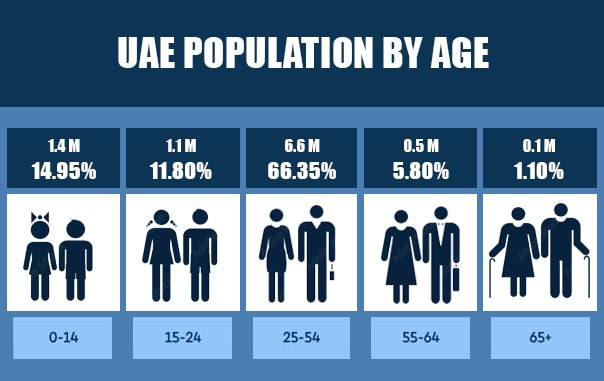
UAE Population Report by Gender
| Age Group | Women | Men | Total |
| 0-14 years | 0.73 million | 0.76 million | 1.49 million |
| 15-24 years | 0.43 million | 0.74 million | 1.17 million |
| 25-54 years | 1.75 million | 4.85 million | 6.60 million |
| 55-64 years | 0.14 million | 0.44 million | 0.58 million |
| 65 years and over | 0.04 million | 0.07 million | 0.11 million |
The 2021 UAE gender ratio is quite interesting to note. Men dominate the chart across all age groups. In the 25-54 years group, males outnumber females by 3.1 million. This can be attributed to the whopping expat population. Of the 1.4 million under-14 kids, males make up 0.76 million and females, 0.73 million. Similarly, between 15 and 24 years, there are 0.74 males and 0.43 females. While the number of men in the 55-64 age group is 0.44 million, the number of women stands at 0.14 million. Currently, in the UAE, there are 0.07 million men and 0.04 million women in the 65+ range.
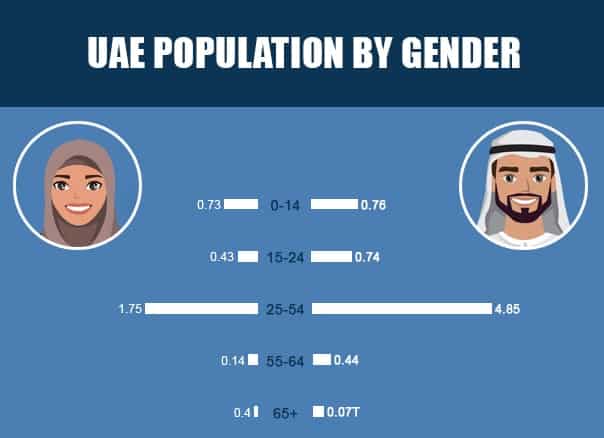
UAE Population Report – Adult vs Minor
The 2021 UAE population stats show that 82.58% (8.24 million) are adults and 17.42% (1.75 million) are minors.
UAE Population Report by Emirates in 2021

Most Popular Social Media Platforms Report in the UAE in 2021
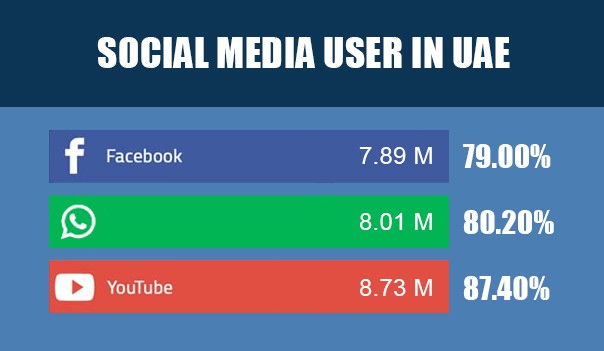
Dubai Population Report in 2021
Today, in 2021, the population in Dubai stands at 3.43 million. From 2.56 million in 2016 the population has grown by over 1 million in just six years. The most populous emirate now has a population density of about 762.6 per sq. km. in the metro area alone. There are 2.36 million males and 1.04 million females in Dubai (according to the latest available data from Dubai Statistics Center).
Dubai is the second-largest emirate in the country with an area of 4,114 sq. km. Located in the southwest corner of the Arabian Gulf, it is hailed as a global business hub and the commercial capital of the UAE. This cosmopolitan metropolis has more expatriates than Emiratis. Though the local population is Muslim, there are Christian, Hindu and Sikh communities.
In 1980, the population of Dubai was roughly 0.27 million. The number rose to 0.68 million in 1995, and 1.3 million in 2005. In 2015, the population crossed the two million mark to reach 2.38 million. In 2018, it again crossed 3 million.
Dubai Population Growth
There are numerous factors for the high population growth rate in Dubai, the most important of them all is its cosmopolitan approach. This has triggered foreign nationals to come and settle in the region, making the expatriate population weigh more than the nationals. In a period of 30 years, the population has grown by millions. Now, with Expo 2020 Dubai ready to roll and the subsequent job opportunities (270,000 additional jobs) it is going to create, there are forecasts that the Dubai population may hit an all-time high in 2030.
UAE POPULATION REPORT 2018
According to an estimate by the World Bank, the UAE’s population in 2018 stands at 9.543 million.
Other sources which confirm this estimate include populationpyramid.com and uae-expatriates.com, while Facebook Insights reveal that the potential reach of the platform in the UAE in the third quarter of 2017 was 9.3 million. We can safely assume that the population of the UAE in 2018 stands at around 9.54 million.
The Federal Competitiveness and Statistics Authority (FCSA) had published the that UAE population according to administrative records until 31 December 2016 was 9,121,167 (9.12 million).
FSCA is a government-backed agency formed to improve UAE’s data and competitiveness capabilities. FCSA claims that the population figures for 2016 are highly accurate and up-to-date. The population figures were derived with the support and collaboration of several national partners and other stakeholders.
The last official census of UAE was conducted in the year 2005, with the population numbers pegged at 4.1 million. The official UAE government website announced that the population stood at 4.8 million in 2008, which indicates that there has been a double-fold increase in the population in a span of 10 years.
Male vs Female Population Report of the UAE in 2018
According to our research, in 2018, males make up 72% of the UAE population at 6.89 million while the number of females account for only 28% of the total UAE population at 2.65 million. That makes the gender split at 72% male – 28% female.
Men outnumber women in all age groups as mentioned in the above infographic. However, the number of males and females in age group 0 to 14 are almost equal.
The number of men under the age group 15 to 24 is double that of women in the same age group. The most significant difference, gender-wise, is seen in age group 25 to 54. There are 4.83 million men within this age group in the UAE whereas the number of women within this age group is just 1.46 million.
Demographics of the United Arab Emirates
The life expectancy in the UAE has been on a steady rise. The majority of the population falls into the 25-54 age bracket, again indicating that immigrants and expats make up a large chunk of UAE’s population.
Age-wise population Report of the UAE
Majority of the UAE population falls in the age group of 25 to 54 years. A large part of this can be attributed to the expatriate population of working men and women who fall in this age category.
The median age for Dubai is 33.5 years.
Expatriate Population Report of the UAE in 2018
As stated previously in this article, expatriates and immigrants account for 88.52%. Emiratis make up remaining 11.48% of the population.
South Asians, which include people from India, Bangladesh, Pakistan and other South Asian nations, compose 59.48% of the population. The rest of population comprises of Egyptians at 4.23% and others at 17.94%. The UAE government’s population strategy envisions in making the Emiratis the majority community or at least bringing the numbers up to 40% by the year 2021.
Digitization and Economic Status of the UAE
The UAE features among the top “adopter” economies in terms of connectivity within the Arab world according to Huawei’s Global Connectivity Index (GCI) 2017. The report analyzed 50 countries, of which 16 were considered as front-runners, 21 as adopters, while the remaining 13 as starters.
Front-runners mostly comprise of developed nations, Adopters have an average GDP per capita of $15,000 and starters are countries with an average GDP capita of $3,000. Adopters focused on increasing ICT demand and working towards digitization and economic growth.
Most popular Social Media Platforms in the UAE
Facebook is the most popular social media in the UAE with 97.48% of population using the social media platform.
WhatsApp is the most popular messenger app in the UAE with 97% of people in UAE using WhatsApp.
YouTube users in the UAE have also increased compared to previous year. According to Adwords insights, 80.92% of the UAE population (7.72 million) uses YouTube.
Emirate-wise Population
Nearly 75% of the population of UAE is concentrated on the northeast of the country. The two biggest cities Dubai and Abu Dhabi have more than 3 million residents each. Dubai, with the busiest port in the region, is the commercial capital of the country. Some of the biggest companies in the world have their headquarters in the city.
Abu Dhabi is the capital of the country. The city houses federal government offices and serves as the seat of the UAE Government. Nearly 95% of the oil and 92% of the gas in the country are in this Emirate, making it the wealthiest Emirate. When considering other entries in the list of city wise population distribution of UAE, Sharjah emerges a distant third from the big two with 1.51 million people. Sharjah’s close proximity to Dubai and much lower living costs can be attributed as reasons for its growth.
How We Arrived At These Figures
The emirate-wise population mentioned here is projected from the last known official population figures released by the UAE government. Several other factors, including the historical population growth rate available from official records as well as events in these emirates which might influence the observed population growth were taken into account before arriving at the final population of each emirate.
The UAE government has conducted 4 censuses since the very first one 1980. when the last census was done in 2005, Abu Dhabi was the emirate with the most population. Since then, Dubai has grown rapidly to become the most populated city in UAE. This is reflected in the latest estimates by the UAE government. The government arrives at these population figures from the citizen and immigration records that it maintains.
Refer below graphs to compare the population change in each emirate.
The Population Boom
Over the years, the country has gone through several key demographic changes. The discovery of oil gave momentum to the economy of the country. Recently, the UAE government has also been promoting a tourism and knowledge-based economy to spur the economic momentum. Today, Dubai ranks among the most visited cities of the world, ranking 6th with 16 million visitors in 2017, as per thisisinsider.com.
According to recruitment agencies, diversification of the UAE’s economy has led to a boom in the number of specialist jobs. With the rise of new establishments and businesses in the UAE, job opportunities are created for talented professionals in various fields including medicine and healthcare, tourism and hospitality, information technology, artificial intelligence, education, digital marketing, SEO, ecommerce, web design and web development, to name a few.
The increase in the number of jobs across sectors led to an influx of workers at all levels of all nationalities. Within a span of a decade, the total population grew by about 5 million. This boom in population was largely due to the burgeoning expat and immigrant population. UAE has the world’s highest net migration rate, with nearly 88.52% of population composed of expatriates and immigrants.
This becomes even more apparent when we look at the fertility rate in the UAE. The average rate of babies born per fertile woman has been showing a downward trend for the past decade, and yet the population is soaring.
An in-depth analysis of the population of the UAE can help marketers formulate plans, goals and strategies to promote their brand. With more than 19 years of experience in the digital landscape of the Middle East, EDS has crafted the digital presence of some of the best brands in the region. We understand what it takes to tap into your target audience on various digital platforms. We can help ideate and weave a digital strategy that works for your brand. Talk to our digital strategists today and take your brand to the people you want to reach.

